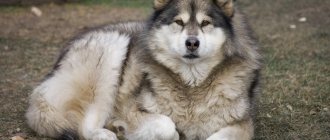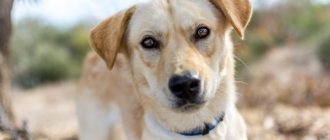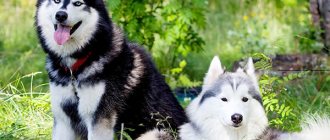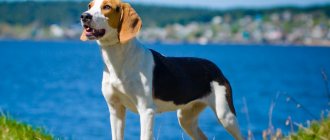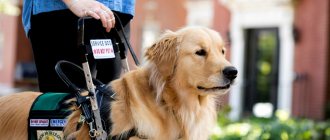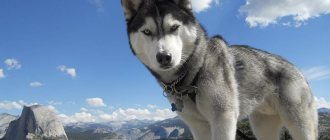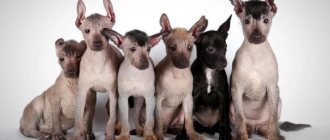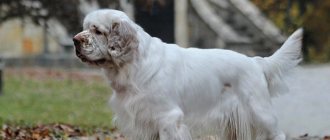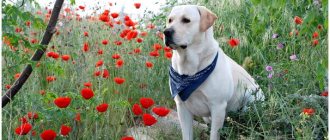Huskies, originally bred and used for a long time as sled dogs, have now become popular as pets and as participants in various dog shows.
However, the fashion for representatives of this breed has led to the appearance of many puppies that do not meet the breed standard. There are also more and more cases when outbred mestizos are sold under the guise of huskies.
Every future owner of a Siberian Husky needs to carefully study the breed standard before going for a pet.
What is the breed standard?
The Husky standard specifies the requirements for both the exterior of dogs of this breed and the characteristics of their character, temperament and behavior..
Having been officially adopted by the FCI in 1966, the breed standard may be subject to amendments or additions if the requirements for dogs are changed or new wishes of specialists appear, which purebred huskies will have to meet from then on.
Despite the fact that the standard was drawn up for all representatives of this breed, not all purebred dogs meet it.
The fact is that huskies have a peculiar division into three intra-breed groups - working, racing and show dogs.
It is the representatives of the latter group that most closely correspond to the breed standard, while working and racing dogs have a rather specific exterior.
After all, their physique, first of all, should be adapted for working in a harness, and not for victories in exhibition rings, when external showiness is the highest priority.
Weight and height at the withers of an adult husky
The gender of dogs does not greatly affect their size. The weight should be proportional to the height at the withers so that the dog looks harmonious. The maximum height during the period of full growth and maturation most often does not exceed 610 mm for males and 560 mm for females. The spread in indicators differs due to the individual characteristics of the animals. Excessive deviations from the Husky standard shown in the table are not acceptable.
| Adult Huskies (1.5 years) | Height at withers (in mm) | Average weight (in kg) | Neck circumference (in mm) |
| Males | 515–610 | 19,3–39,8 | 425-511 |
| Bitches | 491–562 | 14,2–25,3 | 384-460 |
What does the RKF standard look like?
The dog is medium in size, with a compact but not coarse build.
The body is rectangular, tending towards a square format, that is, the height at the withers should be only slightly less than the length of the body:
- The head is proportional, with a moderately defined transition to a muzzle slightly tapering towards the nose.
- The ears are erect, triangle-shaped with slightly rounded ends, medium in size, turned forward when interested.
- The eyes are slightly slanted and almond-shaped. Both dark and bluish-blue colors of the iris are acceptable, and the standard does not prohibit heterochromia.
- The nose is medium in size, with well-opened nostrils. Depending on the color, it can be black, or light or dark brown.
- The neck is medium in length, moderately arched, and raised when standing.
- The shoulder blades are located at an angle of 45 degrees, while straight or too loose shoulders are a serious drawback.
- The chest is strong, powerful and quite deep, but not too voluminous.
- The forelimbs are parallel and level, moderately wide apart, with the elbows fitting tightly to the body.
- The hind legs are parallel, also moderately wide apart, with well-muscled thighs and well-defined angulations of the hock joints.
- The tail is medium in length, resembling a fox's in appearance, carried either lowered or in the shape of a sickle. Twisted into a ring, thrown over the back or tucked between the hind legs is considered unacceptable.
For huskies, the so-called “snow” pigmentation of the nose is also considered acceptable, when there are light veins on a dark background.
Expert opinion
Kozhevin Semyon Kirillovich
Expert dog handler.
“The Husky is a dog of medium height, with a compact but not powerful build. Its head is moderately wide, tapering towards the muzzle, its ears are triangular, erect, its tail is moderately pubescent, drooping downwards or in the shape of a sickle. Sexual dimorphism in these dogs is well expressed: females are lighter in build, but not weak or fragile. One of the most characteristic features of representatives of this breed, which many consider to be a kind of calling card of the husky, is blue or light blue eyes. In fact, among huskies there are many brown-eyed dogs, as well as animals with heterochromia.”
Head
I would rather classify a large head as a disadvantage of the breed. However, being too light and giving the impression of sophistication also does not fit into the standard . In order to understand how proportional the head is, I recommend comparing the distance from the tip of the nose to the beginning of the skull and from the beginning of the muzzle to the back of the husky’s head. As for the width, ideally this breed should have medium width.
Now about what else you should pay attention to:
- Lips – no looseness! But pigmentation, according to the standard, should be there.
- The eyes – their shape in this breed is strictly almond-shaped. They are widely spaced and slightly oblique. An important point: excessive distance is not encouraged, as is close planting. As for the color, of course, those who have ever seen the breed first remember blue. However, huskies often have brown eyes, and even heterochromia - different colors in one individual. The breed even has a mosaic coloration, which is not a defect - when the same eye has different shades.
- Ears – this breed can boast of cute triangular thick ears with rounded ends, located at a relatively short distance from each other. I can say that they are located quite high on the head. Well furred. The standard for Huskies does not include ears tilting forward. According to the same standard, too wide ear cartilage is discouraged, as is excessive softness of the ears, their placement too wide in relation to each other.
- The nose - the transition to it from the forehead should, according to the standard, be clearly expressed. A too narrow and long nose is not welcome. The color of the earlobe depends on the color of the husky: a gray Siberian dog has a black earlobe, a black one has a yellowish-brown earlobe, a copper-red one has a liver hue, and a white one has a flesh-colored earlobe. The breed often showed a nose with a pink stripe or a completely snowy nose - the standard fully allows for this.
- As for the bite, it must certainly be scissor-shaped. All the rest are considered vices.
Anatomical features of the muzzle
The length of the muzzle should correspond to the overall size of the head and be equal to the length of the skull.
The forehead is moderately convex, wider at the top, but tapering towards the muzzle. The stop is not sharp, but at the same time well marked. The bridge of the nose is smooth and straight, and the muzzle itself should end in a slight rounding.
The lips are dense, but not thick, their pigmentation color matches the color of the nose..
The jaws are strong, but not massive, the teeth are complete.
For Huskies, only a correct, scissor bite is considered acceptable.
Health and disease of the Siberian Husky
As a true child of high northern latitudes, the Siberian Husky is distinguished by good health. However, this does not mean that the owner should not monitor the condition of his pet. When purchasing a puppy, study the pedigree of its parents and check if there were any genetically transmitted diseases in its family. For dogs of this breed, most often these may be diabetes mellitus or problems with the thyroid gland, some eye diseases (glaucoma, corneal dystrophy, cataracts), and hip dysplasia. Sometimes Siberian Huskies suffer from epilepsy. This disease cannot be completely cured, but proper care will reduce the number of attacks.
Timely and complete vaccination and careful monitoring of the dog’s condition will help avoid the occurrence of most health-related problems.
It is recommended to periodically examine the animal’s ears, eyes and teeth, and monitor the condition of its fur. Don't ignore your husky's gait. Lameness can be the result of either muscle damage or incipient problems with the musculoskeletal system.
Monitor your dog's weight. Both obesity and wasting are equally harmful.
Timely deworming is very important for the Siberian Husky, especially considering the tendency of dogs of this breed to eat feces (any attempts should be strictly suppressed).
Keeping in mind the northern origin, during summer walks try to choose the coolest and shady places.
If you experience any signs of discomfort, you should immediately contact your veterinarian.
With good care and proper maintenance, the life expectancy of a husky can be more than 15 years.
Shade and color
Huskies have no restrictions on color; any coat color is acceptable for these dogs.
Their most common colors are gray-white and black-white. There are also fawn, brown and white and spotted huskies.
Pure black, white and brownish without white markings are very rare, but are standard and should not be disqualified.
However, despite the fact that almost all husky coat colors are considered standard, there are five main color options, which are recorded in breeding documents:
- White
- Gray-white
- Brown-white
- Fawn white
- Black and white
Typical of most Huskies is the presence of a mask on the face and around the eyes, and many dogs also have a not too wide white mark on the forehead.
Main settings
Only that individual whose parameters correspond to established international standards for all indicators taken together is considered to be purebred.
Color
There are several types of husky color with acceptable deviations.
Kinds
The traditional breed is black and white and a mixture of gray and white, with markings and stripes all over the body. Many individuals are characterized by a typical “mask” around the eyes , vertical stripes on the forehead, and around the nose.
Less common and considered acceptable are brown-white, fawn and spotted colors. The shade of brown is pleasant, soft, with a red or reddish-red tint.
Are there pure white or pure black?
Monochrome specimens are extremely rare. Such a deviation is not a reason for rejecting a dog at competitions. Solid-colored huskies are dogs that are white or black in color.
Rare and unusual colors
Huskies with unconventional coat colors are pigmented:
- brown;
- milk chocolate shade;
- brown-white;
- pibolt.
Albinos
An exclusively white husky is classified as an albino only if its eyes are red. Huskies with a snow-white coat and ice-blue eyes are not classified as albino and are not culled.
Muzzle color
Mask
The typical black mask on a white background goes back to the ears. The width of the ring varies - from a thin contour around the eye slits to a large spot covering most of the muzzle. The mask is also found in brown dogs.
Glasses
The lining around the eyes gives the dogs a certain gloominess. The absence of glasses in bicolor specimens is extremely rare .
Eye color in purebreds
Different eye colors, one blue and the other brown, are typical of the Husky. Two identical blue or brown eyes are normal. The eye section is almond-shaped, with a slightly oblique fit. The eyes are medium apart.
Important ! Husky dogs are prone to all sorts of eye diseases, including cataracts, retinal detachment, and more. They need to be taken to the veterinarian regularly for check-ups.
Wool length
The dog has a good coat, which makes it possible to sleep in the snow in temperatures down to -30° C without the risk of hypothermia. The undercoat falls out intensively during seasonal molting and requires regular brushing.
Standard
The coat of a purebred husky is medium length, very thick, and lies smoothly. The silhouette of the body emphasizes rather than hides. The undercoat is soft, straight, with an angle of departure from the skin of 30 degrees .
Lengths
For a show dog, long hair is a reason for deduction of points, but not a reason for disqualification. There is no clear opinion on this matter. Professional dog breeders believe that this is a sign of impure blood in the pedigree.
Weight
The assessment of the absence of structural defects begins with weighing the dog. The weight of the animal must necessarily correspond to its height, and ensure that the proportions are not violated.
Healthy young males start at 21.5 kg . Some specimens reach 28 kg, but are discarded if the pectoral muscles are overdeveloped. The weight of an average size female is 17-18 kg. The maximum permissible range is 15.5-23 kg.
Height
Height is determined at the withers. For a male, the optimal size will be 51.5-62 cm. For a female, 49-58 cm.
Options
The sizes of males and females do not differ significantly . The priority features of the breed are strong bones of medium build, harmonious proportions, very thick coat. In movement the animal is graceful, runs easily, without visible effort. The gait is smooth, beautiful, characteristic of a sledding breed.
The most important reason for disqualification for a healthy exhibition animal is considered to be excess weight and a heavy gait.
A good dog must meet these criteria:
- the lower back is elastic, the croup descends smoothly from the back;
- proportional, rounded skull of medium size;
- the shoulder blades are directed back, the muscles are well developed;
- the fore and hind limbs are moderately spaced;
- vestigial fingers are missing (removal is recommended).
On a note ! Huskies have a reputation for being runaways. Moreover, it is completely deserved! They can run away from home whenever they want if you don't keep an eye on them.
Neck circumference
At rest, the husky's neck is erect and proudly raised. Looks slightly forward when running. The girth of an adult dog varies from 42 to 52 cm.
Tail
Fox tail type. Characteristic location below the level of the back line. In an excited state, it is twisted, located strictly parallel to the spine without tilting to the side. Hangs calmly when resting, uniformly medium pubescent.
Paws
The forelimb limbs are assessed by looking at the dog from the muzzle. The paws should be medium apart , with the elbows only slightly pointing towards the body. The pasterns are sloping and the joints are strong but flexible. The length from elbow to ground is greater than from elbow to shoulder blade.
The hind legs are oval, not elongated, well haired in the upper part. The pads are elastic, powerful, with hair between the toes.
Other characteristics
- The ears are medium-sized, triangular with slightly rounded tips, set high and close together.
- The correct form of a scissor bite, the slightest deviation from the norm leads to disqualification. The lips are dense, well colored.
- Nose with partial or complete pigmentation. Black in all color types except white. Brown in brown dogs. Two-tone with veining or flesh-colored in white. The difference from the forehead to the muzzle is clearly marked, the back of the nose is always straight.
On a note ! Huskies live on average 12-15 years, provided good care and regular walking!
Any deviation from the above requirements is considered a defect, the degree of deviation corresponds to the degree of severity. The most stringent requirements for show class dogs.
In general, huskies have a lively but gentle character . She is smart, purposeful, self-sufficient. Spoiled males tend to dominate, so the breed is not recommended for undisciplined, weak-willed people.
Paw shape
Husky paws are oval, well adapted to cold climates and snowy winters..
The fingers are tucked into a ball, strong and arched, covered with hair. Many representatives of this breed have fifth, so-called dewclaws, on their front paws.
This is not a breeding match, however the fifth toes on the hind legs must be removed during puppyhood.
Care and maintenance
When purchasing a husky puppy, you must remember that these Siberians simply cannot stay in a limited space for a long time. Any attempt to turn your pet into a “couch” dog is doomed to failure. Movement, active games, good physical activity, long walks - these are the elements of these magnificent animals.
In order for the energy of a dog, especially one living in an apartment, to be directed in the right direction, experts of the breed recommend loading the Siberian Husky to the fullest. Otherwise, the comfort of your home may be seriously damaged. One of the options may be to keep the dog in a cage. Accustomed to this state of affairs from an early age, the husky will react to this quite calmly. Another thing is that for a loving owner, the sight of a friend sitting behind bars will not evoke positive emotions at all, so the best way out still seems to be to “load” the pet to such an extent that he simply does not have the strength for domestic pranks.
Maintenance in a country house also has its own characteristics. Remember that huskies are dogs from harsh regions, and being on the street is not a burden for them. Many owners note that even in severe frosts, animals rest and sleep in the snow, and not in a booth - the spirit of the Arctic reminds of itself.
Be sure to provide your pet with a spacious enclosure. Just don’t use chain-link for this: in a matter of days, the Siberian Husky will turn it into hanging rags. For fencing, use wire at least half a millimeter thick. It is better to lay the floor with natural stone, because these dogs are great experts in digging and will not fail to demonstrate their talent in this matter. If you think that an enclosure is unnecessary, make sure that the fence of your area is a reliable barrier in the way of the husky in his desire to explore and travel far.
The best thing is to find time to take your dog for much-needed walks.
What do you need to purchase before bringing your pet into your home? First of all, these are a couple of bowls for water and food, special “chew” toys, and a rug on which your friend will rest. A little later you will need to buy equipment such as a collar, leash and muzzle. A halter can also come in handy - with its help, even a child can control a Siberian Husky.
Coat type
The husky's coat is thick and warm, not too long, but at the same time dense, perfectly protecting the dog from the cold.
NOTE!
Like other northern Spitz-type dogs, the husky has a double coat of hair, consisting of a well-developed and soft undercoat, as well as a medium-length spine, quite smooth and not bristling.
During shedding, the undercoat completely dies off, which is why the dog does not look as well “dressed” as usual..
Character of the Siberian Husky
Friendliness, liveliness of mind and calm disposition are the main properties of the Siberian Husky. But, speaking about these wonderful dogs, I would not like to limit myself to such a short list.
The ancestors of modern animals, who faithfully served man for many centuries in the harsh conditions of the Far North, passed on to their descendants all the variety of distinctive character traits and behavior that so attract connoisseurs of this breed today.
Huskies, like true sled dogs, are very active and need good, constant exercise.
Representatives of this breed are not suitable for hunting enthusiasts, despite the presence of a fairly strong instinct. For the Siberian Husky, such hunting is one of the ways of subsistence, and it will not share the prey (the dogs were fed only in winter; the rest of the time the team was grazing).
These northern dogs are pack animals, which has led to almost complete elimination of the instinct to protect their own territory, so such pets are completely unsuitable for the role of a guard. The lack of aggression towards humans, even strangers, also does not allow these dogs to be classified as guard dogs. Attempts to embitter the dog can only lead to permanent mental disorders of the animal. Nature has endowed these amazing dogs with well-developed intelligence and the ability to make independent and often extraordinary decisions. Hence the difficulties that arise during training, when certain commands require a template algorithm of actions from the husky. The use of representatives of the breed as service animals is not practiced.
The Siberian Husky is a companion dog. She is perfect for a large family; she will tenderly and reverently love all members of the household, although she recognizes only one as the leader and master. The attitude of these animals towards children deserves special attention. It is difficult to find a more gentle, attentive and affectionate friend for a child. Suffice it to recall that the Eskimos even used huskies to warm newly born babies.
One of the unusual character traits for dogs is the animal's tendency to run away. A door latch or cap hook will not become an obstacle - understanding the principle of their operation for a pet is a matter of a few days. Digging a hole under a fence, and if necessary, overcoming a high barrier is also not a problem. No one claims that your dog will systematically engage in such pranks, but you should still not forget about this feature of the husky.
Dog behavior
Husky has a lively and friendly character. They are smart and quick-witted, and these dogs also have the ability to perfectly adapt to different living conditions, which makes them suitable for both street and apartment living.
Huskies do not have guarding instincts, and although hunting instincts are present, they are not sufficiently developed..
This makes dogs of this breed unsuitable for service and hunting use.
However, their large size and rather stubborn and willful disposition make proper education and training of huskies necessary.
These dogs have a habit of howling rather than barking . In addition, huskies are considered masters of escape: they can make a tunnel in a short time or simply jump over an insufficiently high fence.
But huskies get along well with children and are very sociable, making them very good family dogs.
Character and habits
Huskies are distinguished by high intelligence and the ability to make independent decisions. These dogs are friendly and do not tend to show aggression towards strangers.
Huskies have high intelligence and often do not show aggression.
Attempts to embitter an animal in order to make it a good watchman can cause psychological trauma to the pet. Huskies quickly find a common language not only with all family members, but also with other pets in the house.
One of the characteristics of representatives of the breed is a tendency to escape. If the owner lives in a country house, the height of the fence on the plot should be at least 2 m. Reliable locks and latches should be installed on doors and gates. It is necessary to close the windows so that the dog cannot jump out. It is also necessary to ensure that the animal does not dig under the fence.
Sometimes a pet may show excess in food and ask for more. The owner should not give the animal an additional portion. The desire to eat more is often caused not by hunger, but by illness or stress. If the puppy does not feel full, you should consult a veterinarian.
Unlike representatives of other breeds, huskies hardly bark. However, if the owner is absent for a long time, the dog begins to howl.
Who is the breed suitable for?
Huskies can have:
- Families with children. The dog does not show aggression, even if the child hurts it. The Eskimos used huskies to warm their newborn babies.
- People leading an active lifestyle. The pet will accompany the owner while jogging or hiking. The animal can take part in some sports games.
- Owners of country houses and dachas. In a city apartment, the husky suffers from a lack of personal space.
- Persons prone to allergies. This dog's fur has almost no odor.
Huskies can easily start families with children.
Who are Huskies not suitable for?
It is not worth getting a representative of this breed:
- Elderly or seriously ill people. An elderly person with health problems will not be able to walk the animal 2-3 times a day or play outdoor games with their pet. For the same reason, huskies should not be adopted by homebodies or those who lead a sedentary lifestyle.
- People who have to spend a lot of time at work. Dogs do not tolerate loneliness well. Out of boredom, they often damage their owner's property. At the same time, huskies are suitable for people whose professional activities involve long trips into nature, excavations, etc. (geologists, archaeologists).
- For those who dream of a hunting dog. Huskies are used to getting food only for themselves. They do not share their spoils with anyone.
- Residents of the southern regions. The dog tolerates low temperatures well, but hardly adapts to the heat.
Can a dog change as it ages?
Husky puppies do not have guard hair, and the undercoat of these dogs is lighter, which is why the babies change color with age after the first molt, when the baby coat is replaced by an adult one..
Dogs that become grey-white as adults appear slightly yellowish as puppies, with a creamy coat on their body. Black and white huskies at an early age are grayish in body with white markings.
IMPORTANT!
You can understand what coat color an adult husky will have by looking at the color on its head, which will change little with age.
Also, as the dog matures, it becomes longer-legged, its muzzle lengthens, its chest becomes wider, and well-defined muscles appear.
It should be taken into account that racing and working dogs may look leaner and fitter than show dogs, and visually their legs usually appear longer.
Differences in appearance
Adults
- Male
Male huskies are slightly larger in size: their height can reach 60 cm and weight 28 kg. Outwardly they look larger and more massive. Physical indicators (endurance, strength) are slightly higher than those of females. They can have a variety of colors and eye colors, since this does not depend on gender.
- Bitch
The female has a smaller and more refined body, but her strength indicators remain at the same level. The curves of her body are more graceful, her movements are smoother. The height of husky bitches usually does not exceed 56 cm, and their weight is 23 kg, which makes them more dexterous and agile compared to cables. At the same time, females have less developed muscles and their strength indicators are lower.
Some dog breeders also note that they distinguish the sex of a given breed by the fullness of the tail - in females it is somewhat more magnificent. Externally, gender differences among Husky representatives appear only in size. Much more can be said from the animal's behavior and movements.
Puppy
A healthy purebred puppy has soft, medium-length fur that can come in a variety of colors. The tail is relatively short and well furred. When the baby is interested or excited, his tail rises. A healthy little husky puppy's tail looks like a crescent moon and does not fall over either the back or the side. The body and neck look very short when compared with adults.
The limbs are straight and rather short. The ears are slightly rounded at the ends and stick up, with more feathering than in adults. Newborn husky puppies may not look at all like adults: their ears are pressed tightly to the body, their limbs are short, and their necks are not pronounced.
Dear readers, share your experience of choosing a purebred purebred husky puppy.
How to distinguish a husky puppy from a mixed breed?
There is a list of external features by which you can distinguish a husky puppy from a mixed breed:
- A husky puppy's ears are quite dense, erect, with slightly pointed tips.
- The tail is carried down and never rises above the line of the back.
- The bones are strong and strong, and should not be light, nor too massive and rough.
- The bite should already be correct at an early age, in the form of scissors.
- Little huskies have a lively, moderately inquisitive character, they are energetic and have nothing against communicating with people.
It should be remembered that only the puppy's mark and brand are guarantees of the puppy's purebred, therefore, it is not recommended to buy a husky without documents.
You also need to take into account that without documents about its origin attached to the baby being purchased, blue eyes are by no means a sign that it is a husky.
This trait is often inherited by mixed-breed puppies, including those with unrelated breeds, even such as a German shepherd or pit bull.
History of the Siberian Husky breed
The Siberian Husky is a dog that has been living next to humans for many centuries.
It was bred by the indigenous inhabitants of the Russian Far North. The Chukchi desperately needed a dog that could cover long distances and transport people and cargo from seasonal hunting grounds to camps. Harsh climatic conditions had a decisive influence on both the formation of the animal’s structure and its character. The spread of the breed beyond its centuries-old habitat began actively in the 20th century. The husky's endurance, ability to work harmoniously in a harness for a long time and good speed were appreciated on the American continent. Alaskan mushers increasingly began to purchase these dogs to participate in sled dog racing. The greatest fame was gained by Leonard Seppala's team, led by the legendary Togo, which did not give up the palm for several years in a row. But this musher and his dogs entered the history of mankind primarily because it was his Togo, leading a team, who covered a huge part of the path of the famous dog relay of 1925, delivering anti-diphtheria serum to Nome. A small town in Alaska, cut off from the world by miles of snowy desert, is overwhelmed by an epidemic of a deadly disease. It was not possible to get to it quickly and safely by conventional means: unfavorable weather and natural conditions were not suitable for air or land transportation. And then people turned to the faithful huskies for help. The sled relay covered more than a thousand kilometers in a record five days, and the city's population was saved. The best dogs, led by Togo, covered 146 km - the maximum distance. The dogs walked eighty kilometers on the ice of Norton Bay in forty-degree frost in a snowstorm. Such a feat became possible only thanks to the instinct, courage and endurance of the leader of the pack.
The last team in this relay were the dogs of Gunnar Kaasen, led by Balto, who got all the glory. In memory of these events, grateful people erected a monument to this dog in New York. Statues of Togo and Balto greet guests at the entrance to ClevelandMetroparksZoo, and when visiting the museum in the small Alaskan town of Wasilla, you can see Togo's embalmed body. To commemorate that incredible relay, Alaska hosts an annual multi-day sled dog race.
Further development of the breed took place on the American continent, since in the 30s in the USSR the selection of sled dogs was considered unpromising.
In the USA, for a long time, special attention was paid to the sports component. The crossing of Siberian huskies with native sled dogs of Alaska led to the emergence of mixed breeds, which became much more successful than huskies in racing competitions, although they did not receive recognition from international organizations - the mixed breeds turned out to be very diverse.
A new direction in the history of the breed - exhibition - began from the moment when E. Seely and L. Demidoff first presented a bright black and white dog with blue eyes to the judges. It was since the 70s of the last century that huskies increasingly appeared as a domestic companion dog, quite suitable even for keeping in an apartment.
The return of the breed to its historical homeland, Russia, occurred in the 90s. The first dogs were imported from Belgium and the Czech Republic in 1995, and after five years the number of purebred puppies reached one and a half hundred.
How to choose a purebred pet?
Having decided to purchase a pet of this breed, you need to decide on its future purpose.
The fact is that puppies, even in the same litter, differ greatly in quality: some of them are more promising for exhibitions or for breeding, while others are suitable only for the role of pets.
If you just need a companion, then choosing a baby will not be so difficult: you just need to choose the one of the puppies that you liked more than the others, of course, provided that he is healthy and active enough.
When choosing a show- or breed-class pet, it is recommended to either seek advice from a specialist, or trust the breeder and ask him to select the most promising baby.
When purchasing a husky puppy, you should also take into account that its color may differ significantly from the coat color that will be later, after the pet has shed.
External characteristics of the puppy
Those who want to get a Husky puppy should carefully consider their choice. It is best to buy a dog from time-tested kennels or from experienced breeders. Buying a puppy online can have extremely negative consequences.
Height Weight
Husky puppies continue to actively grow and gain weight for up to 6 months. After this, females begin to develop a little slower than males. Their growth ends at 8 months, muscle gain at about 2 years. Males grow in height up to 9 months. Their development ends completely only at 2-3 years.
Color, wool
The color and coat type of a husky remains the same throughout their life. As the puppy grows, the color of its coat only becomes brighter.
Facts on how to tell if your dog is a husky
- Great runs and great escapes are sometimes daily shows. The Husky's love for running, as well as digging and jumping over fences, is very high.
- This furniture looks chewy . When huskies are sad they can often find something to do, often this includes pieces of furniture or perhaps a garden. So play with him. An obedient husky is an exhausted husky - sometimes they'll do it anyway. Be the Alpha and teach him to play with toys instead of that furniture.
- If your yard looks like a war zone and your husky is in a hole looking at you with those cute blue and innocent eyes as if enemy fire is coming in, you may have a husky.
Recommendations for education and training
Any dog of this breed loves affection and attention. Therefore, during training, excessive praise should not be allowed. Moreover, manifestations of such attention and admiration on the part of strangers should be excluded. Huskies can deliberately provoke this behavior by getting underfoot and begging for treats. From the first days, the dog must understand the primacy of its owner and the need to obey his commands. Being a herd animal, where it is customary for the entire pack to obey the leader, the Siberian Husky will easily accept this state of affairs and will unquestioningly follow the wishes of the owner.
General training recommendations:
- during training, you cannot pick up the animal;
- communication with other dogs should be allowed;
- It is unacceptable to overload with one command for a long time; it is better to repeat these skills after some time or the next day;
- Fairness to your pet is one of the main conditions for successful training. It is necessary to show strictness for sabotaging given commands and generously reward with treats for zeal in their execution.
You should start training with the dog getting used to its own nickname, performing the most primitive commands: “Come to me!”, “Lie down!”, “Nearby!”, “Walk!”, “Sit!”
Accidental mating with a mongrel
In addition to crossing huskies with purebred dogs, there are options when unintentional crossing with outbred four-legged pets occurs. In most cases, it is impossible to predict the result of such a mating; this applies to the exterior of such a hybrid. In addition, there is a big risk in terms of getting a dog with a completely unpredictable temperament.
However, puppies born from such an accidental mating with a mongrel are distinguished by their endurance and extremely rarely have defects in appearance.
Such pets are actively used by humans to protect territory or homes; with skillful training, outbred mestizos will become good companions for humans.
Vices and shortcomings
- Excess weight and protruding bones.
- Eyes that are too slanted or too close-set.
- Ears that are too large in proportion to the head, too widely spaced or not erect.
- Too refined or, on the contrary, very rough, heavy lines of the head.
- Muzzle that is too long or wide, coarse and stubby.
- All types of bite, excluding scissor bite.
- Thick, shortened or very elongated neck.
- Barrel-shaped, too wide chest, too flat or weak rib wall.
- Sagging, hunched, very sloping back.
- Falling onto the back, curled into a ring, the root of the tail is located incorrectly (very high or, on the contrary, low).
- Height over 59 and 55 cm for male and female respectively.
Who is better to choose
The retriever group is known for being obedient, but they need to be fed a lot. Huskies are active and restless lovers of play. Labskis combine these characteristics, but it is difficult to judge from a puppy how he will grow up. When choosing a purebred dog, it is easier to navigate its characteristics and, accordingly, there will be less chance of error.
Each person must independently assess their strength and willingness to work on themselves and their pet.
Labski is an interesting experiment of breeders, and such dogs will be excellent companions and comrades. Heredity plays a big role, but more than 70% of a dog’s character should be developed by a loving and wise owner in the first months of his pet’s life.
Huskies, originally bred and used for a long time as sled dogs, have now become popular as pets and as participants in various dog shows.
However, the fashion for representatives of this breed has led to the appearance of many puppies that do not meet the breed standard. There are also more and more cases when outbred mestizos are sold under the guise of huskies.
Every future owner of a Siberian Husky needs to carefully study the breed standard before going for a pet.
